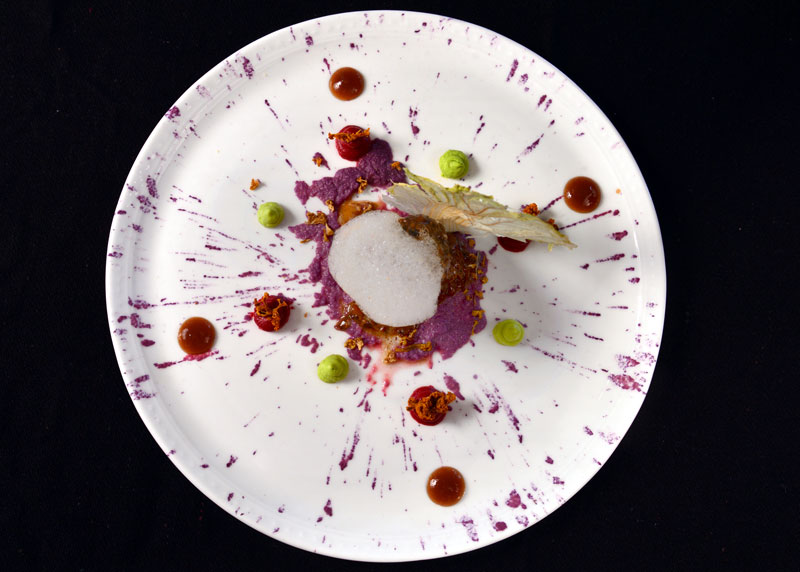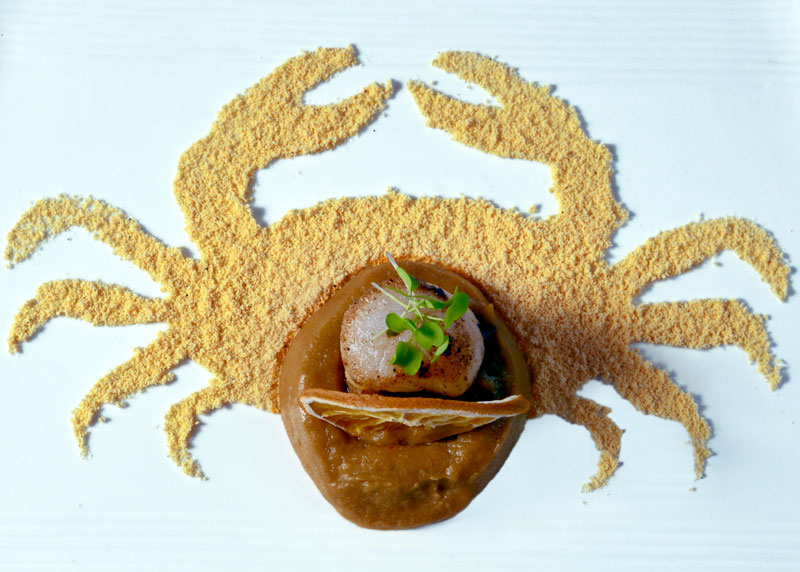Can modern Indian chefs change the way we perceive and experience food in restaurants? It is a difficult question to answer in our relatively young and fickle dining scenario where restaurants close down with the same speed as they open. In this context, Tian at New Delhi’s ITC Maurya demands our attention and some consideration. Captioned the ‘Asian Culinary Studio’ in a city known for its predictable tastes in food, Tian is a bold expression of a ‘no boundaries’ cuisine, inspired by a talented young chef’s imagination and expertise. Vikramjit Roy curates menus that combine flavours from Thailand, Indonesia, Vietnam, Japan and Korea. But you are unlikely to find typical dishes from the region on your plate. Geographical and cultural markers no longer demarcate the menu. Instead, Roy customizes the experience, encouraging interactions with guests, prompting them to express their taste preferences, so that he can work at creating unique experiences –and he ensures that his staff are superbly trained to bring his vision to the table. The wines offered with the menus are carefully selected and paired by Roy, classic offerings from both Old and New World, pairings that change with the menus. In addition, an extensive wine list is on offer by the sommelier. 
Weekday nights –the bête noir of most Indian restaurateurs –are enviably busy at Tian, crowded with a mix of well-known food professionals, the city’s beau monde and walk-in guests. A trembling drop of apple yuzu and betel leaf may precede a lobster Carpaccio with ginger aioli, cucumber, leek ash and caviar, followed by an intense infusion of forest mushrooms distilled into a soup. Sea Bass is exquisitely paired with Japanese mustard, pineapple gel and sichimi; you may be served Schezwan style crispy prawns, caramelized, spiced and baked or Guacamole with miso. What, in the hands of one less skilled, may have been contrived, or even confusing, is at Tian, a seamless play on flavours, textures and aesthetics, sometimes flamboyant, more often subtle, always harmonious, pleasing and thought provoking. The experience begs the question how the enormous amount of thought that went into the creation of each dish was translated onto the plate.
In extended conversations over a couple of days, and further long distance exchanges, there are a couple of episodes from Vikramjit Roy’s early career that stand out vividly, which may define the source of the wide ranging thought and professional skills needed to present menus of this quality.

The first is an image of a young man waiting at Kolkota’s New Market at about 4 a.m. every day, seven months running, for the butchers to arrive and unload carcasses. He would carry his own tools, hang around, watch, ask questions, offer to run errands, wash, clean –no job was too menial for this student hungry for knowledge and hands on experience, who managed to convince the professionals to teach him the intricacies of their specialized craft. Vikramjit Roy, small town boy, Literature undergraduate dropout, brand new student at IHM, showed the same tenacity and passion for learning about food and attention to detail that he now dedicates to every plate presented at Tian.
The second image is of a young chef, driven by what he perceived as the lack of finesse in the Indian cuisine of the day becoming obsessed with classic Japanese cooking techniques. Roy was inspired enough to apply for a job at Okura, Tokyo, which housed two Michelin starred restaurants dedicated to sushi and teppanyaki. When he got the job, he assumed that he would be cooking in one of them. Instead, for about eight months, says Roy, “ I would cycle to the market at 3 a.m. to get fresh fish back to the restaurant. The rest of the day was clean, wash, wipe, prep. I got nowhere near the cooking –I was just washing dishes. If I could have gone back home, I would, but there was no choice.” This, he concedes, was the Japanese apprenticeship that made him the chef that he is today.

A determined Roy refined his skills to become the lone non-Japanese serving Omakase for six at the restaurant. In one of those extraordinary, life-changing moments, one night, a guest waited an hour and a half to eat sushi at Roy’s station. The man, who then offered him a job in New York, was Masaharu Morimoto. Roy left for the United States to work for Morimoto.
The intense learning period and creative freedom at Morimoto in Napa and New York, gave Roy the confidence to introduce new flavour accents and techniques to traditional Japanese cuisine, something he used to good effect to introduce Japanese cuisine to Indian diners when he moved back to lead the team at Wasabi. “Morimoto gave me the freedom to experiment,” he says, and I was able to manipulate flavours to suit the Indian palate, without undermining the integrity of the cuisine.”
Restless, talented, Roy was soon onto another project, in many ways a precursor to Tian: ITC Grand Chola’s Pan Asian restaurant, conceived on an operatic scale, was in some ways an ‘angry young man’s’ response to the idea that Chennai was not ready for Asian food (an assumption that somehow failed to take into account the fact that the people have had long historic, cultural and trade links with South East Asia).

“ The vision of Asian food itself was so limited,” says Roy, “ I wanted to challenge it, using my understanding of flavour patterns and raw materials.” Within three months of opening, Pan Asian would soar to the number one spot on a popular website, demonstrating that his dishes, invested with deep thought, could hold strong popular appeal too.
The inspiration for Roy’s plated compositions is found in museums, literature, art, nature –in short, the world beyond the culinary, and yet, the appeal, as the success of his restaurants have shown, is deep, elemental, cutting across cultures. “I want to go into spaces that people don’t believe in and work the change,” says Roy. In some ways, his art and philosophy are distilled into one single dish of his creation: young onion shells, stuffed with home made sakura miso, crusted with dehydrated nettles, a representation of a ‘sakura’, cherry blossom tree on a plate. For Roy, this celebration of exquisite beauty, the transient nature of life, represented by the Japanese custom of Hanami, ‘flower viewing’, the flowering, the blooming, the falling of the leaves induces a state of contemplation and calm in the moment. “It is very deep,” he says, “ a time zone where hunger and thirst are forgotten, a moment that lasts beyond time.” This is an offering from a man who spends his life bringing profound thought to the table in the simplest of creations.
This article appeared in Sommelier India Magazine, Volume 11, Issue 5&6, October-December 2016.
Image Credits: ITC Hotels





Superb article on Vikramjit Roy ! Insightful and well researched – very interesting to read his slogs in Japan. Years ago I was there for his guest chef degustation in Edo, Bangalore and I was impressed by everything including the gentleman himself. Am glad that he , along with a select few, represents the future of modern Indian chefs.